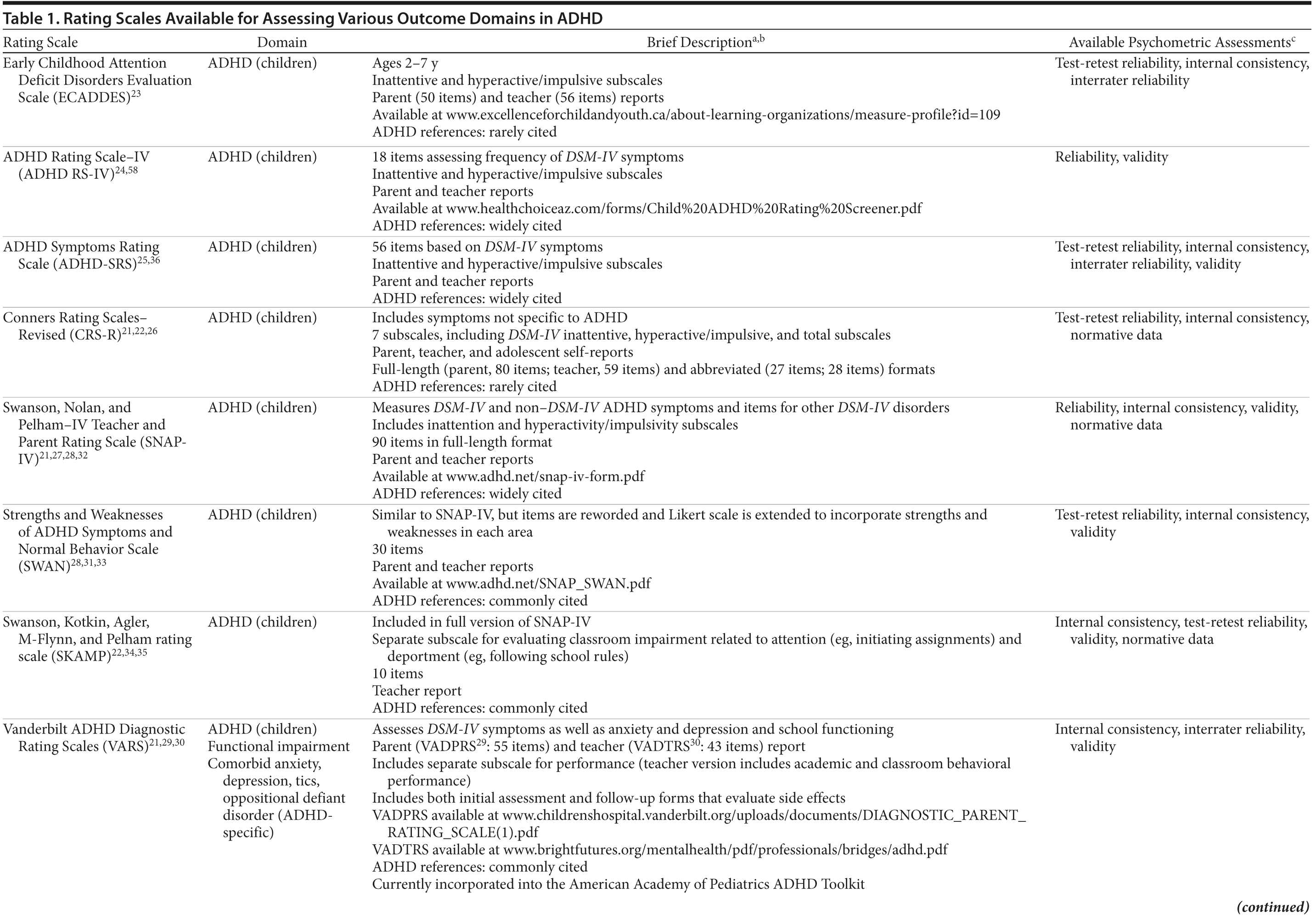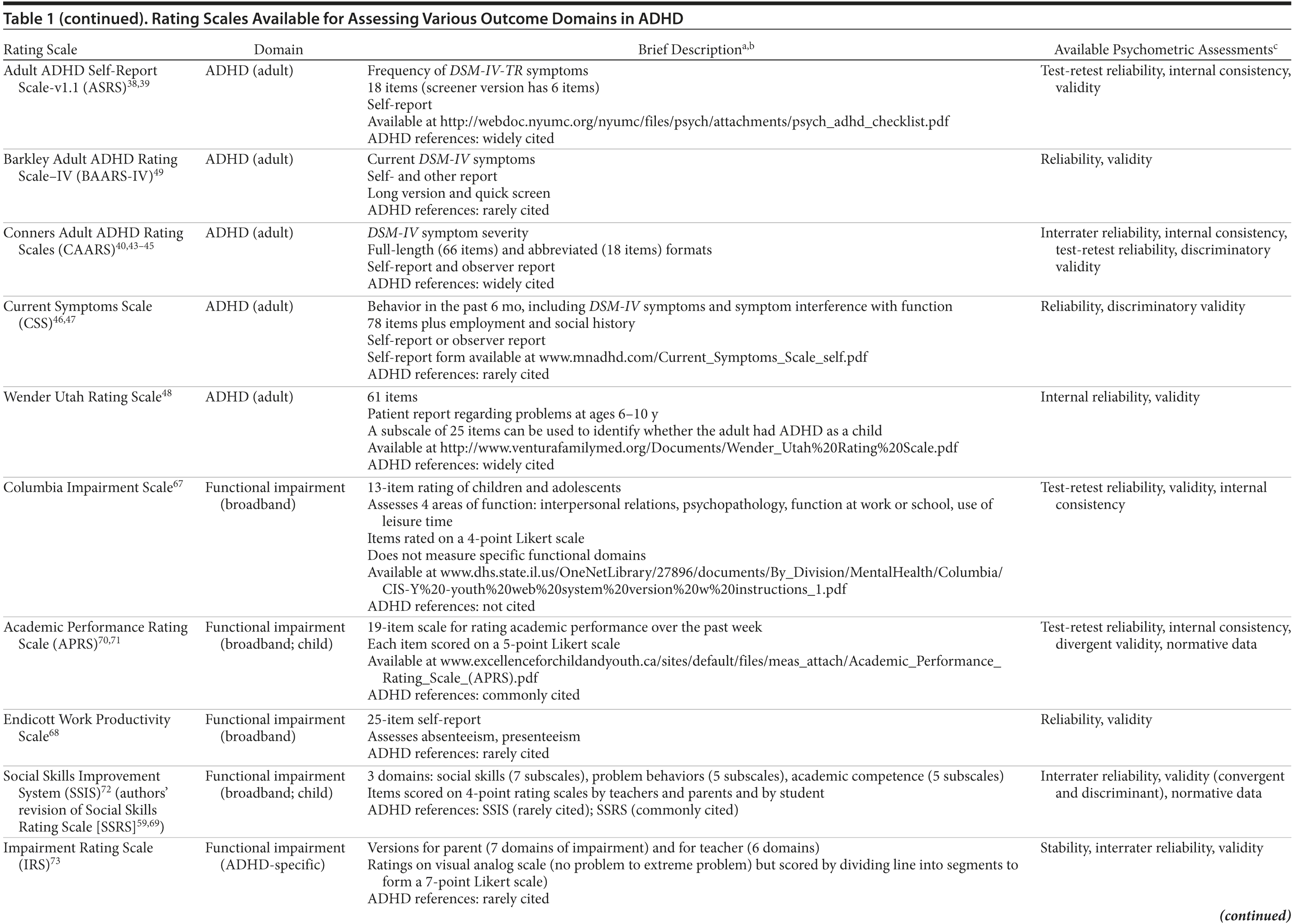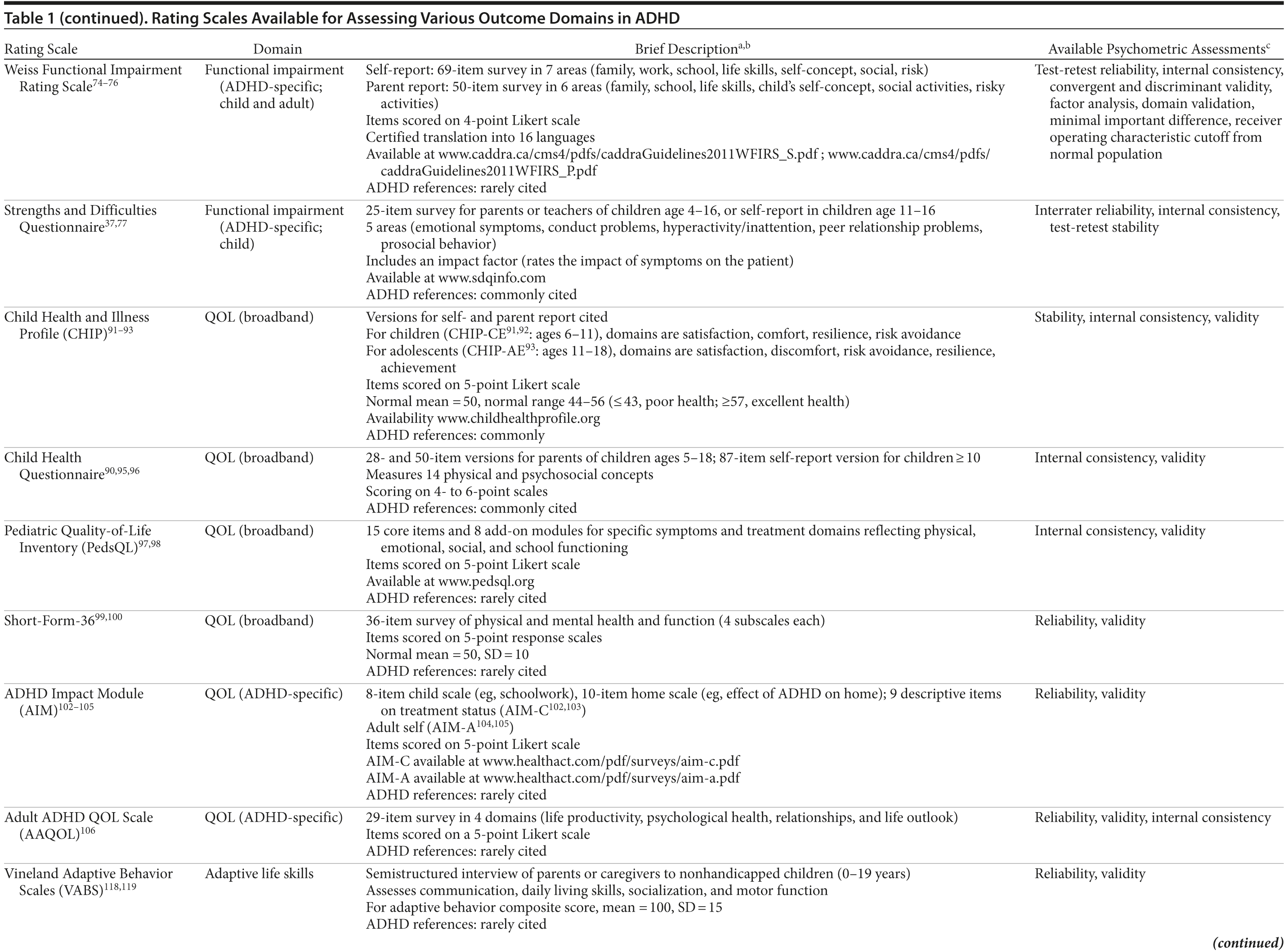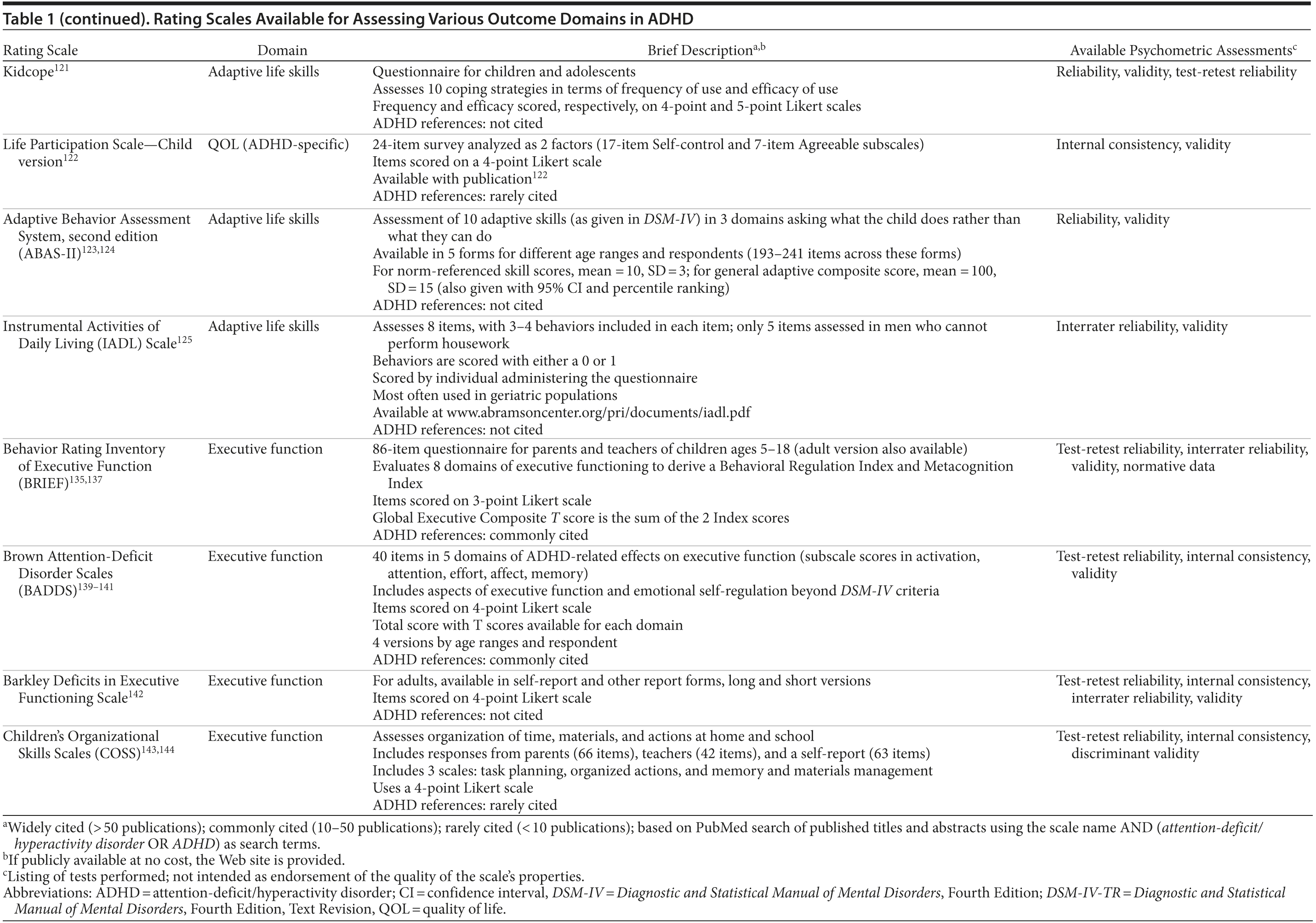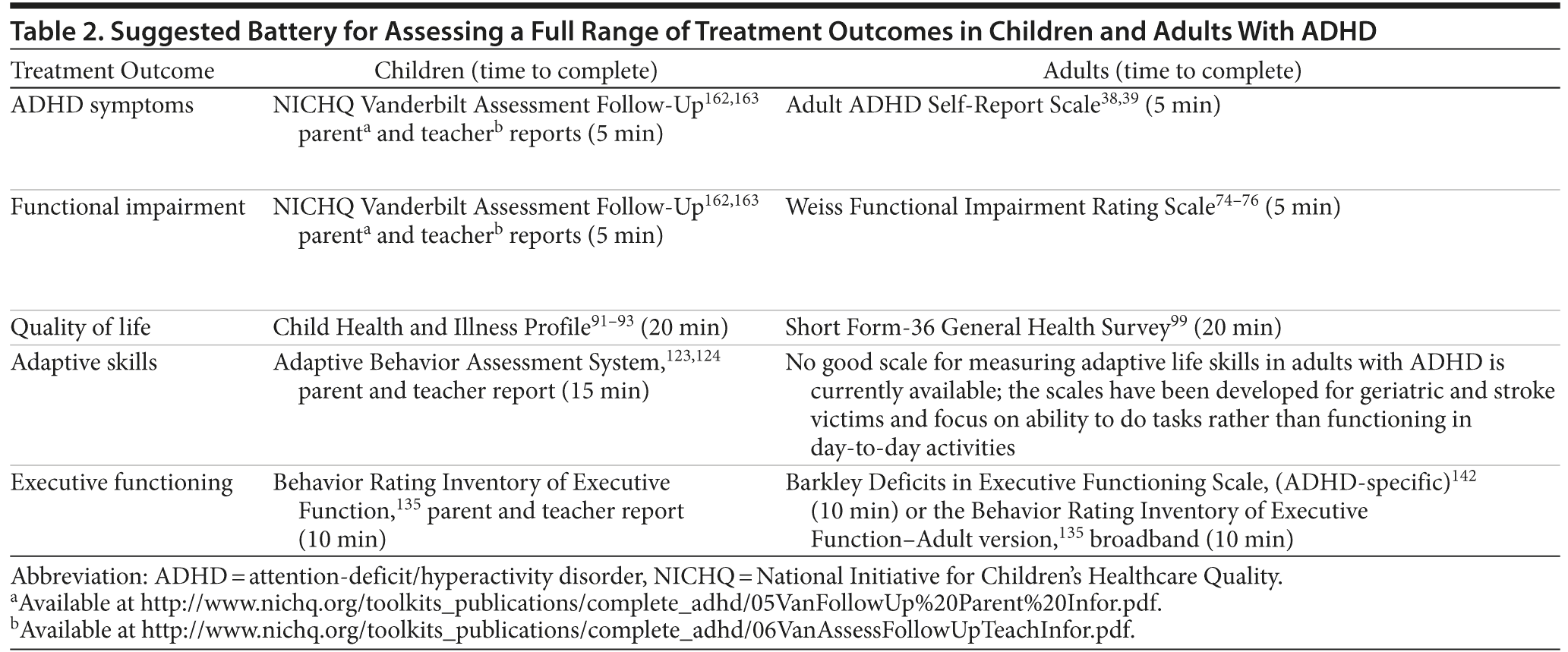Assessing Treatment Outcomes in Attention-Deficit/Hyperactivity Disorder: A Narrative Review

ABSTRACT
Objective: To review measures used to assess treatment response in patients with attention-deficit/hyperactivity disorder (ADHD) across the life span.
Data Sources: Keyword searches of English-language articles in the PubMed database up to and including the May 4, 2011, index date were performed with the search strings (1) (attention deficit disorder with hyperactivity [MeSH] OR ADHD) AND (outcome assessment [MeSH] OR adaptation of life skills OR executive function [MeSH]) and (2) (attention deficit disorder with hyperactivity [MeSH] OR ADHD) AND (function OR functioning OR quality of life [MeSH]).
Study Selection: Articles found through this search were then selected based on relevance to the topic area; no specific quality criteria were applied.
Data Extraction: Narrative review.
Results: The vast majority of studies assessing ADHD treatments have measured treatment response using ADHD symptom measures. Additional domains relevant for assessing treatment response among children and adults with ADHD include functional impairment, quality of life, adaptive life skills, and executive function. Validated rating scales exist for assessing these additional domains, but there has been minimal research evaluating the sensitivity of these instruments for detecting treatment response in pediatric and adult samples.
Conclusions: Assessment of treatment outcomes in ADHD should move beyond symptom assessment to incorporate measures of functioning, quality of life, adaptive skills, and executive function, especially when assessing long-term treatment response. The authors recommend a potential battery and schedule of measures that could be used to more comprehensively assess treatment response in patients with ADHD.
Prim Care Companion CNS Disord 2012;14(6):doi:10.4088/PCC.11r01336
© Copyright 2012 Physicians Postgraduate Press, Inc.
Submitted: December 19, 2011; accepted May 11, 2012.
Published online: November 29, 2012.
Corresponding author: Jeffery N. Epstein, PhD, Cincinnati Children’s Hospital Medical Center, 3333 Burnet Ave, ML-10006, Cincinnati, OH 45229-3039 ([email protected]).
An estimated 9.5% of children aged 4 to 17 years1 and 4.4% of adults2 in the United States meet diagnostic criteria for attention-deficit/hyperactivity disorder (ADHD). Pharmacologic and behavioral therapy can be effective treatments for ADHD,3-6 as reflected in ADHD treatment guidelines.7-10 However, assessment of treatment response in patients with ADHD has generally been limited to narrowly focused measures of ADHD symptoms as defined by the Diagnostic and Statistical Manual of Mental Disorders, Fourth Edition, Text Revision (DSM-IV-TR),11 with relatively little attention to other relevant outcome domains.4,5,12
Patients with ADHD are most often referred for treatment because of dysfunction in familial, social, emotional, academic, and occupational roles rather than because of ADHD symptoms.13 Children are often referred for diagnosis and treatment because of poor academic performance, difficulty making friends, or low self-esteem (functional impairments) rather than because they cannot remain seated or they lose things or interrupt others (ADHD symptoms). Because functional impairments are a primary impetus for seeking treatment, they may be the most appropriate targets for assessing treatment response.14 Although behavioral symptoms show moderate correlation with functional impairments, assessment of symptom improvement alone may not adequately reflect changes in functional status.15 There is a strong need to broaden outcome assessments to encompass a multidimensional array of outcomes in patients with ADHD.12,14
We recognize 5 core conceptual areas that are integral to assessing treatment outcomes in ADHD: (1) DSM-IV-TR ADHD behavioral symptoms; (2) functional impairment in familial, social, emotional, academic, and occupational areas; (3) quality of life (QOL) or the burden of illness on the daily lives of patients and their families; (4) adaptive life skills (the development of strategies and skills to cope with problem behaviors); and (5) executive function (working memory, goal-directed activity, planning, organization, prioritizing, self-monitoring, and self-regulation).16,17 These overlapping but distinct concepts each contribute to the real-life outcome of the patient. Although some of these concepts are poorly differentiated in the literature and current measurement approaches, we believe that each should be considered when assessing ADHD outcomes. The objective of this review is to discuss approaches for measuring ADHD treatment outcomes in these 5 core conceptual areas.
METHOD
PubMed searches were performed in the days leading up to and including May 4, 2011. The following search strings were used:
(1) (attention deficit disorder with hyperactivity [MeSH] OR ADHD) AND (outcome assessment [MeSH] OR adaptation of life skills OR executive function [MeSH]);
(2) (attention deficit disorder with hyperactivity [MeSH] OR ADHD) AND (function OR functioning OR quality of life [MeSH]).

- Attention-deficit/hyperactivity disorder (ADHD) impacts multiple domains, beyond the characteristic symptoms of hyperactivity, impulsivity, and inattention.
- A meaningful assessment of treatment effectiveness requires measures of functionality, quality of life, adaptive life skills, and executive function, as well as reductions of ADHD symptoms.
- Validated rating instruments are available to assess the effects of treatment in all of these domains.
Search fields were limited to the title/abstract (string 1) or title (string 2); both searches were limited to humans and English-language articles. Additional references were identified using the “related citations” function of PubMed and by reviewing the reference lists of obtained articles.
Our intent in this narrative review is to clarify multiple concepts relevant to the assessment of ADHD. Research in these areas varies in quality and, in some cases, is largely underdeveloped. Therefore, articles were selected based on their relevance to the topic area and were not systematically evaluated based on their methodological quality. Table 1 provides a summary of the scales described in this review. Their frequency of citation in the ADHD literature, based on a PubMed search of titles and abstracts for each scale by name, is provided to place their use in historical context. However, frequency of citation should not be construed as an index of a scale’s quality.
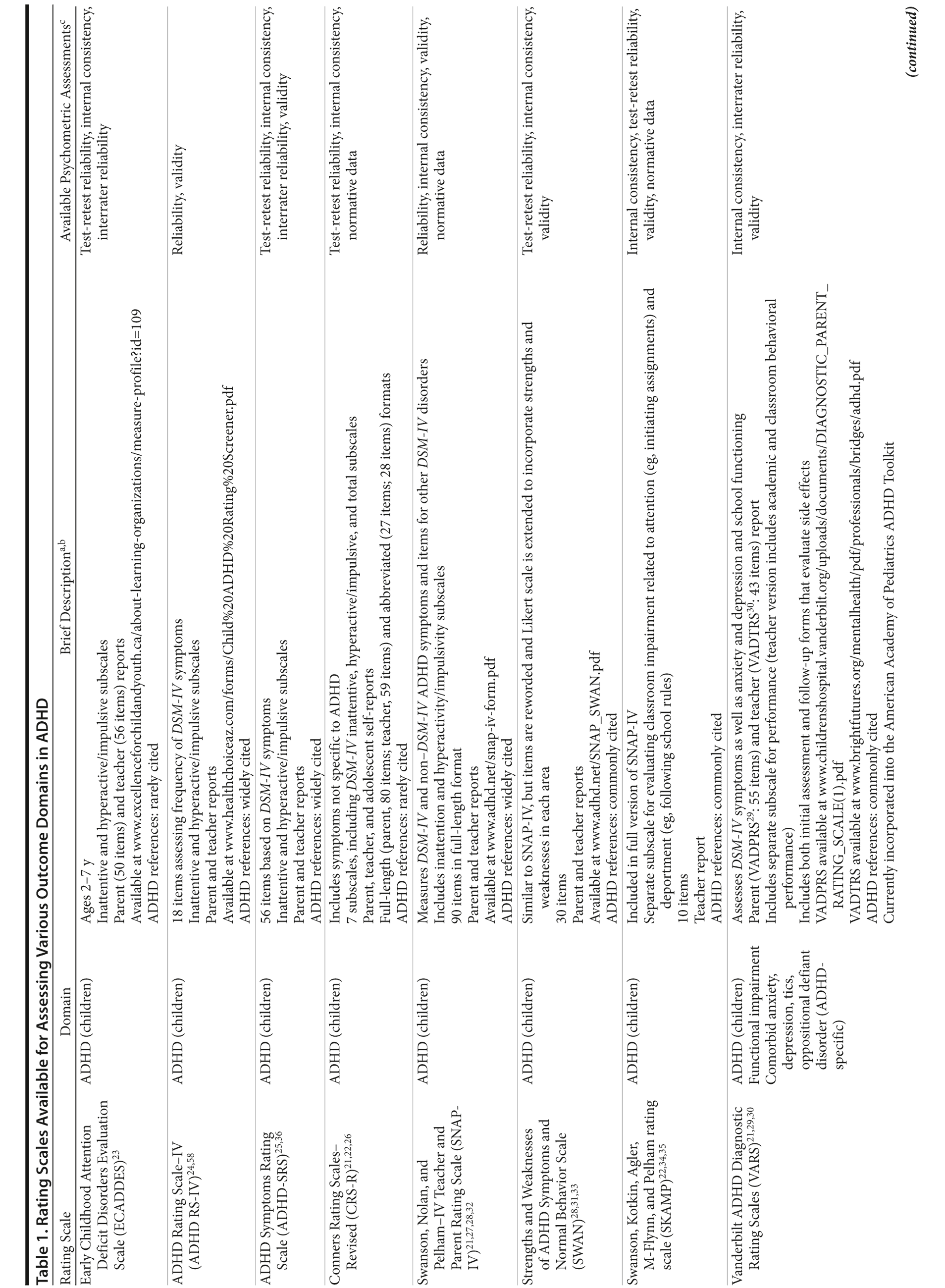
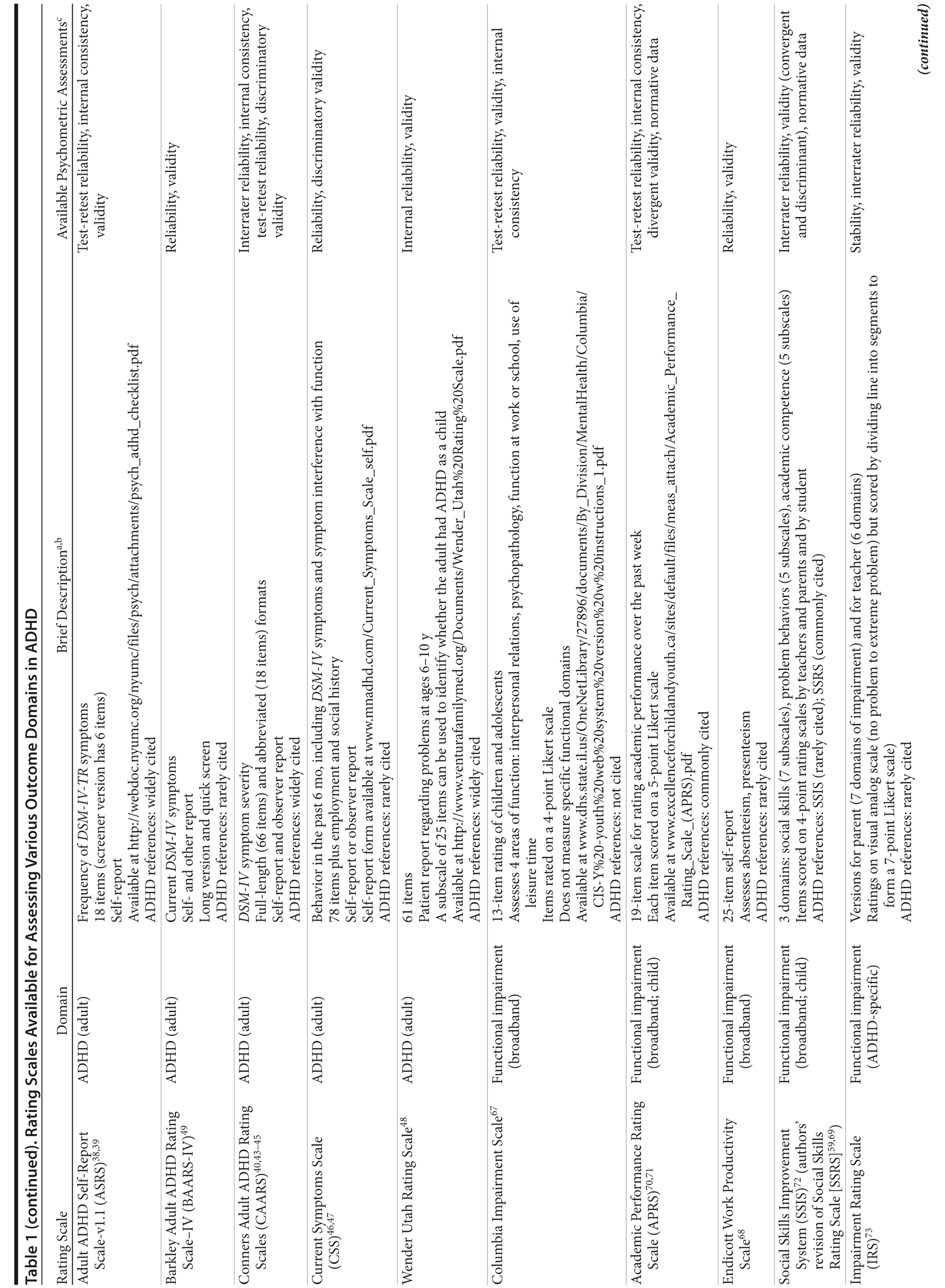
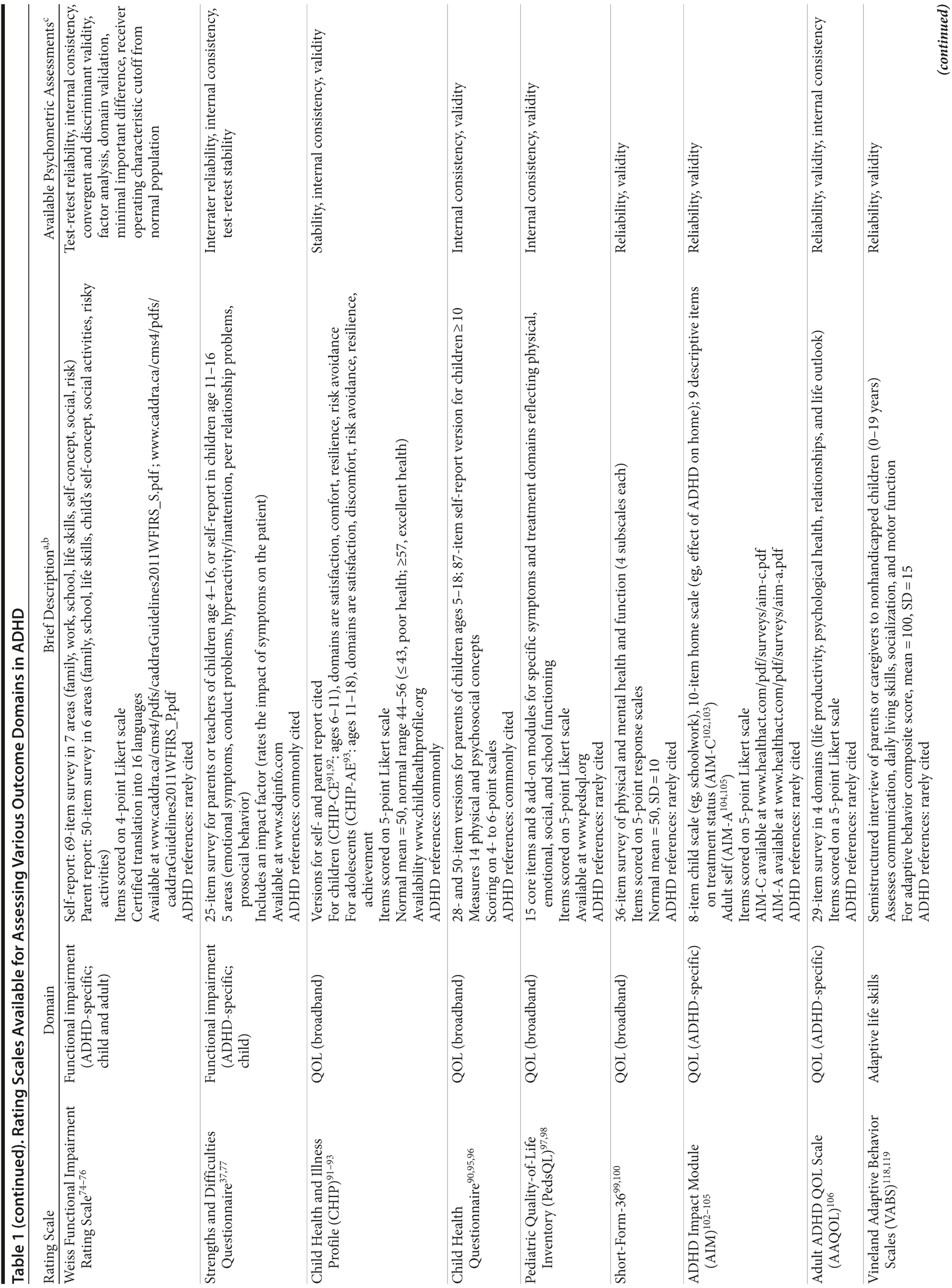
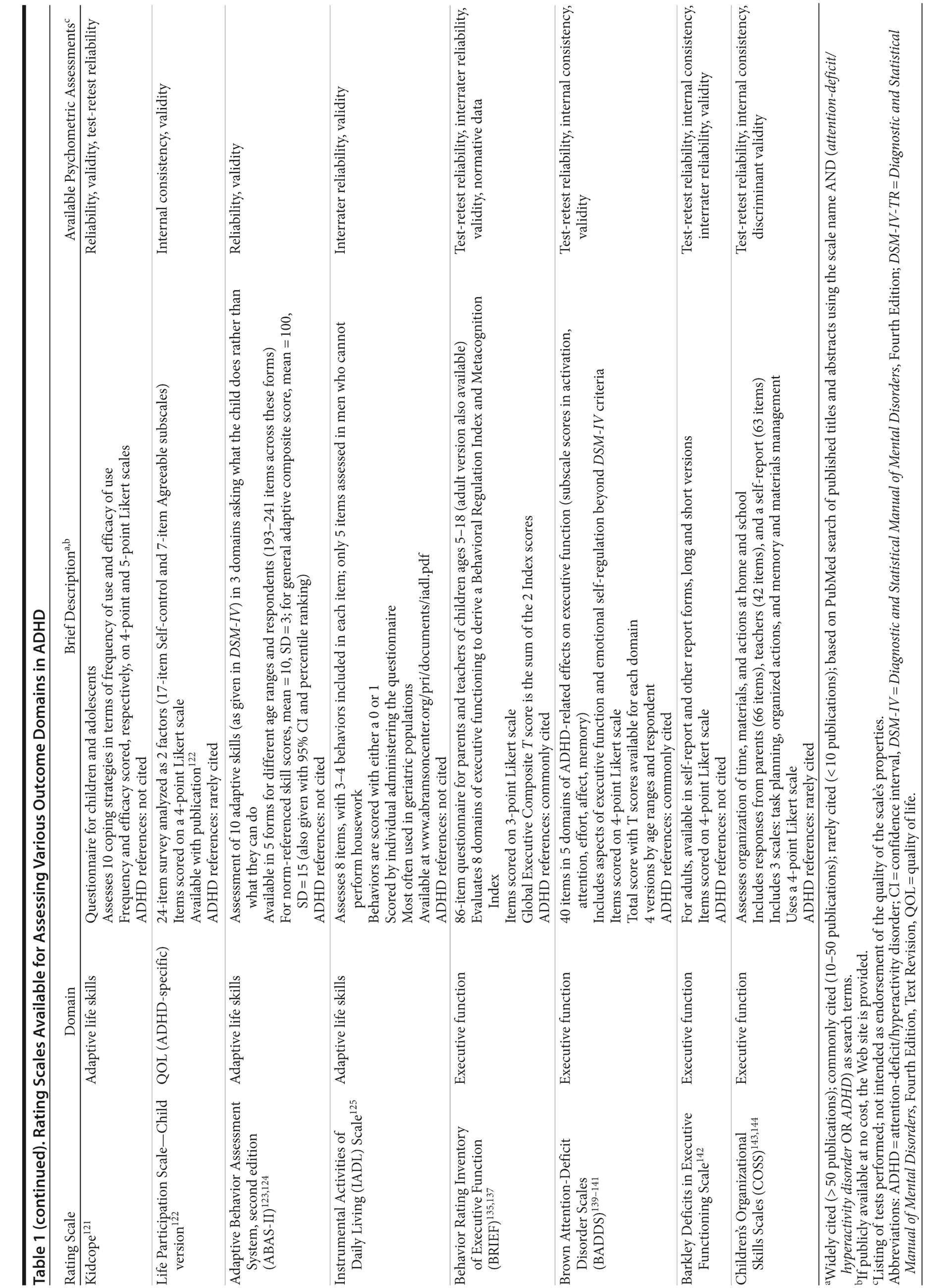
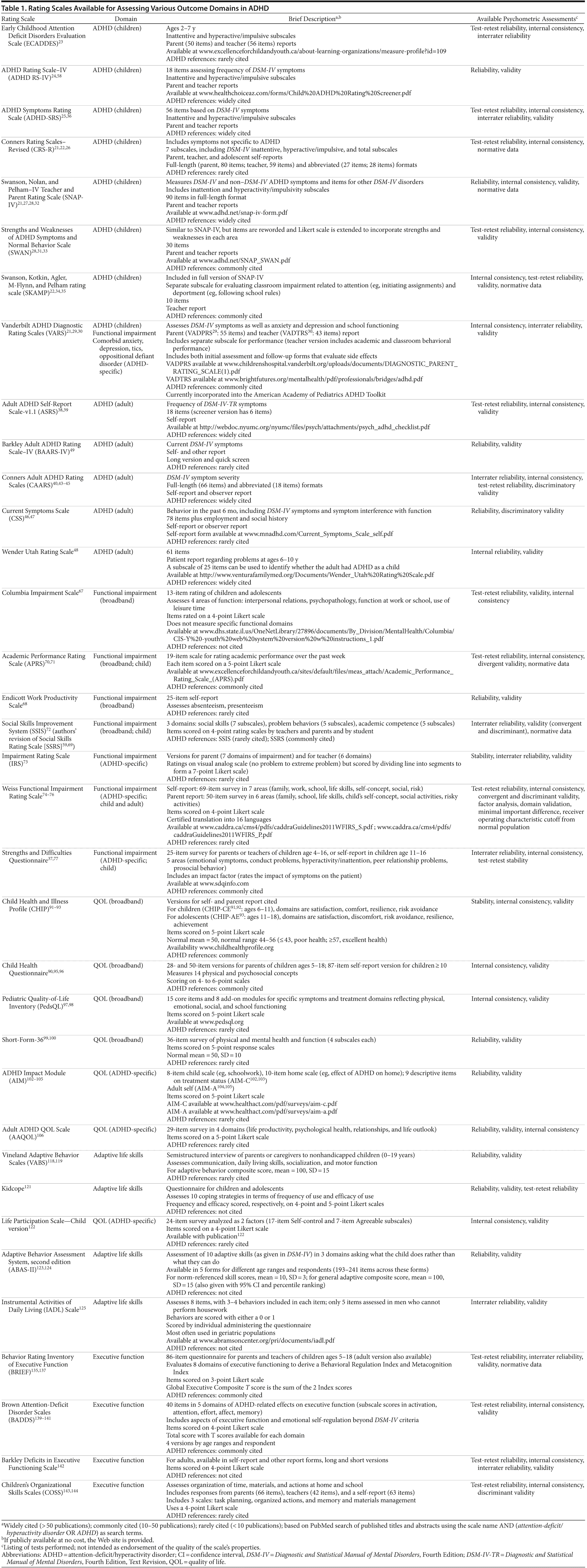
SYMPTOMS
The core ADHD symptoms observed in children, as reflected in the DSM-IV-TR11 criteria, are inattention, hyperactivity, and impulsivity. However, symptom manifestation differs considerably across the life span. Although hyperactivity and impulsivity may improve with increasing age, symptoms of inattention are more persistent, and the presentation of symptoms in all 3 domains shifts with changing developmental challenges.18,19 The DSM-5 diagnostic criteria are expected to better reflect symptom manifestation of ADHD in adults.18,20
Measurement Approaches
Reviews by Collett et al21 and Madaan et al22 provide detailed descriptions of ADHD rating scales for children. Differences among scales include length, scope (eg, broad band vs narrow band [ADHD-specific]), rater (eg, parent or teacher), and psychometric validation. Differences across scales relate mainly to minor differences in wording or anchor points and whether symptoms are assessed by frequency versus severity. Essentially, all scales measure the 18 symptoms of DSM-IV-rated ADHD, with most using 4-point Likert scales (Table 1).23-31 Sensitivity and test-retest reliability are particularly important for treatment monitoring.
Although ADHD rating scales are generally reliable,14 the adequacy of normative and/or psychometric data are less well established22 for the Swanson, Nolan, and Pelham-IV Teacher and Parent Rating Scale (SNAP-IV)27,28,32 and the Strengths and Weaknesses of ADHD Symptoms and Normal Behavior (SWAN).28,31,33 A short rating scale, such as the Swanson, Kotkin, Agler, M-Flynn, and Pelham rating scale (SKAMP),34,35 may be more convenient for the clinician than a longer scale, such as the Early Childhood Attention Deficit Disorders Evaluation Scale23 or the ADHD Symptoms Rating Scale.25,36 However, the SKAMP was designed as an observational tool for the laboratory or classroom rather than for the clinical setting. The 18-item ADHD Rating Scale-IV (ADHD RS-IV)24 and the abbreviated 27-item Conners Rating Scales-Revised26 are good options for symptom-based outcome assessments based in part on good psychometric properties.21,22 Clinicians in primary care may be more likely to use scales in the public domain, such as the Vanderbilt ADHD Diagnostic Rating Scales,29,30 the SNAP, the SWAN, or the Strengths and Difficulties Questionnaire.37
Several adult ADHD rating scales are also available (Table 1), including the Adult ADHD Self-Report,38,39 the Conners Adult ADHD Rating Scales,40-45 and the Current Symptoms Scale.46,47 Assessment of adults requires demonstration of a childhood history of ADHD in addition to current symptoms. The Wender Utah Rating Scale, which has established validity, provides a simple and reliable way of confirming a childhood diagnosis when collateral information, report cards, or the patient’s recollection of early development is insufficient.48 In most cases, scales are modified from those originally developed for children, using descriptive language appropriate for adult patients. One of the few adult ADHD symptom scales empirically derived using an adult population is the Barkley Adult ADHD Rating Scale- IV.49 This instrument has established reliability and validity. It includes a quick screen, a battery of scales developed to assess current symptoms, and informant report of childhood and/or current symptoms; it also assesses impairment in different domains.
The accuracy of a clinical assessment can be improved when symptom information is acquired from more than 1 source (eg, from parents and teachers of children with ADHD).42 Teachers may be better able to report daily behavior because they see the child when medication is at its peak and they observe the child in a structured environment in which medication effects (eg, ability to sit still, ability to concentrate for long periods) are most likely to be apparent. Furthermore, teacher reports, based on comparison and experience with peers in attention-demanding settings, may be more sensitive to ADHD behaviors that are less salient in a home environment. Both teacher and parent rating scales can be useful to obtain detailed knowledge of social and academic performance, adaptive skills, differential diagnosis, and the child’s strengths and key disabilities. Similarly, in adults, rating of symptoms by an observer (eg, spouse) in addition to a self-report rating can contribute useful information.50
Treatment Effects
A change in ADHD symptoms has been the standard measurement of treatment response and demonstration of efficacy relative to placebo. Treatment effects on ADHD symptom scales usually have moderate-to-large effect sizes.4-6 A meta-analysis of 32 studies that evaluated the effects of stimulant and nonstimulant medications in children across 20 different measures reported a large overall effect size (Cohen d = 0.78) for ADHD symptom improvement.4 A separate meta-analysis of 18 studies in adult ADHD that incorporated 18 different symptom outcome measures demonstrated statistically significant symptom reduction with large effect sizes for short- and long-acting stimulants (Cohen d = 0.96 and 0.73, respectively) and moderate effect sizes for nonstimulants (Cohen d = 0.39).5
Positive effects of behavioral therapy on ADHD symptoms are well established in children, with effect sizes (Cohen d) ranging from 0.39 to 3.70 depending on study design and rater (eg, parent or teacher).3 There are now 6 randomized controlled trials of cognitive behavioral therapy (CBT) and other psychological treatments in treated and untreated adults, all demonstrating medium-to-large effect sizes.51-56
FUNCTIONAL IMPAIRMENT
People with ADHD exhibit impairment in behavioral, academic, and social functioning.57-59 Children with ADHD as young as 3 years demonstrate impoverished social skills and more problem behaviors in home and school environments compared with children without ADHD.58,59 In a longitudinal study of children from birth to a median age of 18.4 years, those with ADHD had significantly lower reading achievement scores and approximately 3-fold higher rates of grade retention and dropout compared with controls.57 In the Multimodal Treatment Study of Children with ADHD, those with ADHD had poorer social skills and were less socially accepted than children without ADHD and had inaccurate social perceptions of themselves.60
Studies in adults demonstrate the chronicity of these impairments. Blase et al61 reported that, among 3,400 university undergraduates, those with self-reported ADHD had significantly lower grade point averages, poorer emotional stability, and greater academic and social concerns than students who had never been diagnosed with ADHD. In a community sample of 500 adults, those with a self-reported ADHD diagnosis were significantly less likely to have graduated from high school or college or to be currently employed and significantly more likely to report relationship problems compared with those without an ADHD diagnosis.62 Among married adults, those with ADHD report poorer marital adjustment and family functioning than those without ADHD.63
Measurement Approaches
Multidimensional rating scales assess multiple domains of impairment, whereas domain-specific scales assess a single domain of impairment. Narrowband scales are specific for ADHD-related impairment, whereas broadband scales assess impairments across a range of psychopathologies (Table 1).
Broadband scales15,59,63-70 that have been used in children and adults include the multidimensional Columbia Impairment Scale67 and the domain-specific Academic Performance Rating Scale (APRS),70,71 Endicott Work Productivity Scale,68 and the Social Skills Improvement System,72 which is an update of the Social Skills Rating Scale59,69 (SSRS). According to Pelham et al,14 multidimensional measures are shorter and less costly yet correlate well with more extensive domain-specific scales. Some scales include a single question on impairment, thus providing a global impairment rating. Given the considerable variability in domains of functional impairment across individuals (eg, a child may be impaired academically but not socially), multidimensional scales are preferred over those with only a global rating.14 A multidimensional rating scale also indicates appropriate concomitant treatments (eg, tutoring for a child with specific academic impairment or marital therapy for an adult with specific problems in spousal communication).
Compared with these broadband functional impairment rating scales, narrowband rating scales are relatively brief, because they focus only on areas of impairment noted to be most problematic in patients with ADHD. The Impairment Rating Scale (IRS)73 is a brief multidimensional instrument for children with ADHD. Both the parent version, assessing 7 domains (relationship with peers, relationship with siblings, relationship with parents, academic progress, self-esteem, influence on family functioning, and overall impairment), and the teacher version, assessing 6 domains (relationship with peers, relationship with teacher, academic progress, self-esteem, influence on classroom functioning, and overall impairment), have acceptable to excellent stability, evidence of validity, and reliability.73 The Vanderbilt ADHD Diagnostic Teacher Rating Scale (VADTRS)30 and Vanderbilt ADHD Diagnostic Parent Rating Scale (VADPRS)29 are primarily ADHD symptom scales but also include performance subscales to assess multidimensional impairment in areas such as reading, writing, mathematics, and relationships. The Vanderbilt scales have established concurrent validity and internal consistency.21
The Weiss Functional Impairment Rating Scale74-76 is a clinician-friendly tool completed by a parent or adolescent/adult that scores distinct domains (school [learning and behavior] or work, family, social, leisure, self-concept, and risky activities) on a 4-point Likert scale. The scale, translated into 9 languages, has excellent internal consistency, intercorrelation between domains, validation by factor analyses, test-retest validity, sensitivity to change, and receiver operating characteristics to determine cutoff scores and normative data. It has also been analyzed to determine reasonable change/minimal important differences (unpublished data, M.D.W.), so it can be used as a primary outcome in clinical trials. The scale is in the public domain (available at www.caddra.ca)74 and, like the Strengths and Difficulties Questionnaire (www.sdqinfo.com),77 is free and designed to facilitate clinical as well as research use.
Treatment Effects
A 2008 meta-analysis of randomized controlled trials in children with ADHD reported significant effects of behavioral therapy and methylphenidate on social and academic functioning.78 Additional randomized controlled trials have broadened these findings, demonstrating significant improvements in social, emotional, academic, and before-school functioning in children receiving ADHD pharmacotherapy.65,79,80 However, a case series of 785 children with ADHD treated by community physicians generally using pharmacotherapy demonstrated large improvements in ADHD symptoms (VADTRS and VAPRS) but only limited improvement in functional impairment (teacher rating of writing and assignment completion).81 These findings suggest that global functional improvement very likely requires multimodal treatment to address ADHD-related impairments. Consistent with this conclusion, combined treatment with atomoxetine and behavioral therapy produced significantly greater improvements in some aspects of functioning, including parent-rated problem behaviors (on the SSRS), academic progress (on the IRS), and impulse control (on the APRS), than atomoxetine treatment alone.65 Data from a randomized trial of atomoxetine also suggest that functional improvements in those who respond to treatment may be maintained with long-term psychosocial therapy.80
Data on functional outcomes in adults are sparse. A 2008 meta-analysis of pharmacotherapy in adults with ADHD found no studies evaluating academic, workplace, or social functioning.82 However, randomized trials by Adler et al64 and Retz et al66 suggest that pharmacotherapy improves family, social, and workplace functioning in adults with ADHD.
QUALITY OF LIFE
Studies using parent reports of QOL uniformly demonstrate significantly lower ratings across psychosocial domains (eg, behavior, self-esteem, mental health, and emotional functioning) in children and adolescents with ADHD versus individuals without ADHD, whereas differences in physical domains have not generally been found.83-85 Although self-report may be more relevant than an observer’s report of the impact of ADHD on QOL, children with ADHD have been noted to have a positive illusory bias,86 raising questions about their reliability in reporting QOL. The few studies that have incorporated self-report offer less consistent evidence for reduced QOL in children and adolescents with ADHD.83,87 Available data suggest that adults with ADHD have significantly lower self-ratings of QOL compared with those without ADHD across global, social, and occupational domains.88,89
Measurement Approaches
Most QOL measures are multidimensional, assessing a range of physical and psychosocial health outcomes (Table 1). Numerous multidimensional measures have been used to assess QOL in children with ADHD.83 Because multidimensional measures often include items that are not relevant to ADHD (eg, questions about pain interference with daily activities),90 those with separate ratings for physical and psychosocial domains may be preferable.
The Child Health and Illness Profile (CHIP-CE), a multidimensional QOL measure for children (6-11 years)91,92 and adolescents (11-17 years),93 assesses health in 5 domains: satisfaction, comfort, resilience, risk avoidance, and achievement. CHIP-CE can be completed as self- or parent-report. Both scales can generate separate t scores for each domain and have good psychometric characteristics.91,93 The CHIP-CE items are closely linked to functional impairment associated with ADHD, with less emphasis than other scales on irrelevant aspects such as pain or mobility. The CHIP-CE has also been validated in ADHD in a large European multinational study.94
The Child Health Questionnaire (CHQ)90,95 is another commonly used multidimensional measure with self- (for ages ≥ 10 years) and parent-report versions. The parent version is available as a 50- or 28-item form encompassing 14 concepts of physical and psychosocial functioning that can be assessed as separate summary measures. The CHQ has been psychometrically validated in children and adolescents with ADHD.96
The Pediatric Quality-of-Life Inventory (PedsQL)97,98 was developed for pediatric cancer patients but can be used across pediatric chronic health conditions to assess health-related QOL in terms of physical, psychological, and social functioning. It comprises patient self-report forms for children (8-12 years) and adolescents (13-18 years) and parent proxy-report forms. Psychometric characteristics suggest good reliability and validity.97
For adults, the Short Form-36 General Health Survey (SF-36)99 is a broadband tool providing a multidimensional QOL assessment (physical functioning, bodily pain, social functioning, general mental health, physical and emotional role limitations, vitality, and general health perceptions) in 5 to 10 minutes. Internal consistency, test-retest reliability, and construct validity have been established.100
Data from Weiss et al101 suggest that ADHD-specific QOL measures may be more sensitive than multidimensional measures. ADHD-specific rating scales include the ADHD Impact Module (AIM), which is available in a child version completed by the parent (AIM-C)102,103 and an adult self-report version (AIM-A).104,105 The AIM-C includes subscales evaluating QOL at home and the impact of ADHD, as well as 9 items assessing treatment status, history, and demographic information. The AIM-A has 4 global QOL items, 5 economic impact items, and 5 subscales (living with ADHD; general well-being; work, home, and school performance and daily functioning; relationships and communication; and impact of symptoms). Psychometric data from limited clinical samples indicate acceptable internal consistency, validity, reliability, and sensitivity.103,105
In adults, the Adult ADHD QOL Measure (AAQOL) assesses health-related QOL during the past 2 weeks.106 The 29-item measure provides an overall score and 4 subscale scores (life productivity, life outlook, relationships, and psychological health).106 Psychometric data show good reliability, validity, and sensitivity.106,107
Treatment Effects
Based on studies using different measures, there is good evidence that ADHD pharmacotherapy can improve QOL in children and adolescents with ADHD.80,83,85,108 Manos et al108 demonstrated significant improvement in AIM-C QOL scores with very large effect sizes (Cohen d ≥ 1.5) in children treated with transdermal methylphenidate for 8 weeks. Data also suggest that QOL improvements are maintained with prolonged treatment (eg, 40 weeks to 2 years).80,85 Studies using the AAQOL and AIM-A have also reported significant improvement in QOL in adults with ADHD receiving pharmacotherapy.64,88,109 In a large community-based sample of adult patients with ADHD, Weiss et al101 demonstrated that treatment with long-acting mixed amphetamine salts simultaneously improved symptoms (measured by ADHD RS-IV) and QOL (AIM-A and SF-36). The effect of psychosocial treatment on QOL is an area of needed research.
ADAPTIVE LIFE SKILLS
Adaptive functioning (“activities of daily living”) refers to the ability to interact with society and to care for oneself. It represents one aspect of overall functioning that targets the individual’s ability to meet the demands of his or her environment and to manage routine tasks of self-care. Relatively few studies have measured adaptive life skills in ADHD. Despite the fact that adaptive life skills are outcomes that might be expected to be responsive to medication, studies to date have suggested that this is an area that is often severely impaired and treatment resistant. Russell A. Barkley, PhD, author of ADHD and the Nature of Self-Control,110 has written, “ADHD is not a disorder of knowing what to do but one of doing what one knows.”111(p8) This is particularly obvious in activities of daily living; for example, a child may know how to shower and brush his teeth but fail to carry through these activities on his own initiative.
Stein et al112 demonstrated that children with ADHD have significantly impaired adaptive functioning across several domains (eg, daily living, socialization, and communication) compared with normative data. A similar discrepancy between average intelligence and impairment of adaptive functioning was reported by Roizen et al.113 Stein et al112 suggest that children with ADHD fail to perform routine tasks because of inattention, poor self-control, and motivational deficits. Others suggest that people with ADHD develop maladaptive and counterproductive coping strategies (eg, blaming, avoidance, and resignation) owing to high stress levels and inadequate social support structures.114,115
Adults may be particularly vulnerable to adaptive dysfunction as a result of many years of living with ADHD and the repeated reinforcement of negative thoughts and beliefs.116,117 As a result, maladaptive coping strategies, such as brinkmanship and procrastination, may emerge.117
Measurement Approaches
Tools for measuring adaptive functioning are limited (Table 1). The Vineland Adaptive Behavior Scales (VABS)118,119 can be used to assess adaptive functioning in children and young adults (≤ 19 years) across communication, daily living skills, socialization, and motor domains; it is administered as an interview with the parent or primary caregiver.119 The VABS has good psychometric characteristics119 and has been used to demonstrate adaptive dysfunction in ADHD.112,113
Other assessments include indirect evaluation of self-esteem and self-efficacy55,120 and the use of a multidimensional coping scale such as the Kidcope,121 which asks adolescents to rate the frequency of use of 10 coping strategies. The Kidcope has been used to evaluate outcomes of these strategies in hyperactive girls.115,121 Psychometric data suggest adequate reliability and concurrent validity.121 Another ADHD-specific measure for children with ADHD is the 24-item Life Participation Scale, which assesses changes in adaptive functioning related to ADHD treatment in home, school, and social environments.122 Psychometric evaluation indicates adequate to good internal consistency, responsiveness, convergent validity, divergent validity, and discriminant validity.
The Adaptive Behavior Assessment System (ABAS) is a reliable and well-normed scale completed as a parent or teacher report that provides standard scores for communication, functional academics, self-directed activity, leisure, social skills, community use, home living, school living, health and safety, and self-care.123,124 The ABAS has been widely used as an indicator of the need for services. The Instrumental Activities of Daily Living (IADL) Scale is an 8-item, clinician-administered questionnaire typically used in geriatric populations; interrater reliability is good.125
Treatment Effects
Further research is needed to evaluate treatment effects on adaptive functioning. However, there is some limited research addressing the effects of behavioral therapy on this outcome. Both CBT and ADHD coaching encourage the development of coping strategies to replace ineffective behaviors resulting from negative thoughts and beliefs.114,116
EXECUTIVE FUNCTION
Children and adolescents with ADHD demonstrate deficits in executive functioning (eg, memory, executive attention, planning, task switching, and response inhibition) across multiple neuropsychological tasks.126-129 A study in adolescents reported a nearly 3-fold higher frequency of such deficits in individuals with versus without ADHD (52% vs 18%).127 In adulthood, the daily demands on executive function tend to increase owing to increasing responsibilities and diminishing parental support. As such, the negative impact of deficits in cognitive and executive function in adults with ADHD is not unexpected.130,131
Measurement Approaches
Traditionally, executive function has been assessed using neuropsychological tests that target discrete tasks considered representative of executive functioning. Tests suggested to have particular utility in ADHD128 are the Continuous Performance Test (sustained and selective attention and impulsivity), Stroop task (reaction time and cognitive flexibility), Trail Making test (visual attention and task switching), verbal fluency test (short-term memory), Wechsler Adult Intelligence Scale (general cognitive function, working memory, and processing speed), Stop-Signal test (inhibitory control), and Paced Auditory Serial Addition test (working memory, sustained and divided attention, and processing speed).132-134
Neuropsychological tests require considerable training to administer, so simpler and faster options are desirable in the clinical setting (Table 1). The Behavior Rating Inventory of Executive Function (BRIEF) for children and adolescents aged 5-18 years (86 items)135 and BRIEF-A for adults aged 18-90 years (75 items)136 evaluate multiple domains of executive functioning (inhibition, shift, emotional control, self-monitor [adults only], initiation, working memory, planning/organizing, organizing materials, and task monitoring). The first 3 (4 for adults) and last 5 domains are used to derive a Behavioral Regulation Index and Metacognition Index, respectively, which can be summed to obtain a Global Executive Composite score. The BRIEF includes separate questionnaires for parents and for teachers; the BRIEF-A includes a self-report and informant report. The BRIEF and BRIEF-A have good psychometric characteristics, with normative data available for children and adults.135,136 Because children with ADHD were included in the BRIEF validation, the manual includes a section on clinical utility in ADHD.135,137 There is some overlap between ADHD symptom scales and the BRIEF.138
The Brown Attention-Deficit Disorder Scales (BADDS),139 developed based on clinical interviews, have separate rating scales for individuals aged 3-7, 8-12, 12-18, and ≥ 18 years.140 A self-report is available for ages 8-12 years, and the version for ages ≥ 12 years incorporates a self-report and observer report. Adolescent and adult scales comprise 40 items spanning 5 clusters of executive functioning (activation, focus, effort, emotion, and memory); the child and adolescent scales include 1 additional cluster for self-regulation. Psychometric characteristics are good across these age groups.141
The Barkley Deficits in Executive Functioning Scale (BDEFS) evaluates multiple dimensions of adult executive functioning in daily life, including time management, organization and problem solving, self-restraint, self-motivation, and emotional self-regulation.142 The BDEFS, available as a self-report and other report and in long and short form, has high internal consistency and test-retest reliability, good interobserver agreement, and demonstrated validity. Unlike the BRIEF, which has adolescent and adult versions, the BDEFS measures executive function exclusively in adults. The BDEFS is easily obtained at minimal cost.
The Children’s Organizational Skills Scales (COSS)143,144 assess how children organize their time, materials, and actions to accomplish tasks at home and school; it is a multi-informant assessment that includes responses from parents and teachers and a self-report.
Neuropsychological testing reveals that some but not all children with ADHD have enduring executive dysfunction.145 The prevalence of executive dysfunction is much higher with narrowly defined rating scales than with broadly defined tests18,146 and probably has greater ecological validity with narrowly defined scales. This is particularly true since many of the most critical aspects of executive function, such as carrying through with long-term goals, require assessment over time that is impossible in a cross-sectional evaluation on a single battery of psychological tests. Using self-ratings of executive functioning from the Adult ADHD Clinical Diagnostic Scale, Kessler et al18 identified executive function deficits in 78% of patients who met full childhood and adult ADHD criteria. Executive function and mood regulation are salient impairments in ADHD.147,148
Treatment Effects
Stimulants can significantly improve some aspects of executive function. In children, improved executive function has been demonstrated using neuropsychological tests149 and the BRIEF.79,150 There have been attempts to systematically determine whether methylphenidate affects the working memory component of executive function. In an elegant series of experiments, Bedard et al151-154 have demonstrated that methylphenidate can improve visual spatial working memory and listening.
In adults with ADHD, data from an open-label trial of lisdexamfetamine dimesylate155 and pooled data from 2 randomized controlled trials of triple-bead mixed amphetamine salt88 demonstrate improvement across all 5 BADDS clusters. Biederman et al156 reported that young adults with ADHD currently taking stimulants had significantly better sustained attention and verbal learning scores on neuropsychological assessments than did those not currently taking stimulants. There were no significant differences in aggregate scores or scores for working memory, interference control, set shifting, visuospatial organization, and processing speed. Cognitive-behavioral therapy treatments that specifically target executive dysfunction, such as time management and organization training for school, or the CBT for adults with ADHD programs,157-159 have all demonstrated moderate-to-large effect sizes in improving executive function.
DISCUSSION
The literature suggests that patients with ADHD exhibit impaired functioning, QOL, adaptive skills, and executive function that often persist throughout their lives. These areas of dysfunction are the problems that lead patients to seek treatment. Although ADHD symptoms are a core aspect of diagnosis, focusing on symptom improvement as a treatment outcome is insufficient, because symptoms represent only part of outcome. When initiating a new treatment (eg, titrating medication), it is appropriate to collect symptom ratings to assess response, because ADHD symptom ratings are most sensitive to treatment response in the short term. However, once treatment is stabilized, it becomes necessary to assess additional domains to ensure that meaningful improvement is realized in patients with ADHD.
During initial titration, as well as during maintenance of treatment, it is critical that ratings be collected from multiple raters (eg, parent and teacher for a child; self and spouse for an adult), because the level of agreement among raters may be low. For example, in a report by Lavigne and colleagues,160 it was noted that agreement between parent and teacher ratings for ADHD symptoms was too low for clinicians to rely only on parent reports. This may be especially important when assessing multiple domains of functioning (eg, academic impairment), for which input from other raters (eg, teachers) provides a broader and often more objective perspective regarding improvement and degree of impairment than is typically found in parent ratings or in adult self-ratings. Ratings indicating residual deficits in functionality, QOL, adaptive life skills, or executive functioning suggest the need for escalation of current treatment or, more likely, for additional treatment modalities to remediate the full breadth of ADHD-related impairment.
We have demonstrated that there are now psychometrically sound measures of adaptive skills, executive function, functioning, and QOL in ADHD. Thus, we believe that it is currently feasible to broaden outcome assessments beyond symptom rating scales. In an attempt to provide guidance to mental health professionals treating patients with ADHD, we have derived a sample battery of measures that could be used to assess the full range of outcomes discussed in this article (Table 2). We have selected assessment batteries for children and adults using measures that are readily accessible, economical, comprehensive, and sensitive to treatment effects. Moreover, to be parsimonious, we have preferentially selected measures that assess multiple domains in a single instrument as opposed to selecting different instruments for individual domains. We also have included time estimates (55 minutes for the child test-battery; 40 minutes for the adult battery) to demonstrate that the suggested battery should not place an undue burden on patients or their families, especially because such assessment of treatment response need only occur 2 to 4 times per year.
We also propose that a broader range of measures be included in ADHD treatment outcome research. The vast majority of ADHD treatment outcome studies have examined pharmacologic treatments, and most pharmacologic studies have focused on ADHD symptoms as the primary outcome. Studies like the Multimodal Treatment Study of Children with ADHD suggest that, although medication may be superior to psychosocial treatment for improving ADHD symptoms, psychosocial treatment alone or in combination with medication may better target other areas of impairment (eg, parent-child relationship and academic functioning).161 We believe that adding other measures of outcomes can elucidate areas in which pharmacologic treatments may be ineffective and identify other treatment modalities (eg, psychosocial treatment) that may be necessary to address areas of impairment in patients with ADHD.
Additional research is needed to characterize interrelationships among these concepts. This will also require measures that avoid redundancy and confusion between distinct outcomes. Further research on functioning, life skills, executive function, mood regulation, and QOL will provide us with a better understanding of the patient’s life experience of ADHD, which moves beyond whether or not they still meet DSM-based diagnostic criteria. Given the uncertain reliability of patient report (eg, positive illusory bias), this research should also improve our understanding of differences in perspective.
This review is limited by the absence of a quality assessment of the studies cited and the absence of studies that review the interrelationships between different outcomes. We have demonstrated that our field has grown beyond core symptoms to examine not just the disorder but the patient’s overall well-being.
Drug names: atomoxetine (Strattera), lisdexamfetamine (Vyvanse), methylphenidate (Focalin, Daytrana, and others), mixed amphetamine salts extended release (Adderall XR).
Author affiliations: The Department of Pediatrics, Cincinnati Children’s Hospital Medical Center, Cincinnati, Ohio (Dr Epstein); and The Department of Psychiatry, University of British Columbia, Vancouver, BC, Canada (Dr Weiss).
Potential conflicts of interest: Dr Epstein has received research funds from Eli Lilly. Dr Weiss has received research funds, honoraria and consulting fees from Janssen, Eli Lilly, Shire, and Purdue.
Funding/support: Shire Development LLC, Wayne, Pennsylvania, provided funding to Complete Healthcare Communications, Inc (Chadds Ford, Pennsylvania) for support in writing and editing this manuscript.
Role of sponsor: Although Shire Development LLC was involved in the topic concept and fact checking of information, the content of this article, the ultimate interpretation, and the decision to submit it for publication in The Primary Care Companion for CNS Disorders was made by the authors independently.
Acknowledgments: Under the direction of the authors, Nicole Strangman, PhD, of Complete Healthcare Communications, Inc, provided writing assistance for this publication. Editorial assistance in the form of formatting, proofreading, copy editing, and fact checking was provided by Maryann Travaglini, PharmD, of Complete Healthcare Communications, Inc. Thomas Babcock, DO, and Manisha Madhoo, MD, from Shire Development LLC also reviewed and edited the manuscript for scientific accuracy.
REFERENCES
1. Visser SN, Bitsko RH, Danielson ML, et al; Centers for Disease Control and Prevention (CDC). Increasing prevalence of parent-reported attention-deficit/hyperactivity disorder among children—United States, 2003 and 2007. MMWR Morb Mortal Wkly Rep. 2010;59(44):1439-1443.
2. Kessler RC, Adler L, Barkley R, et al. The prevalence and correlates of adult ADHD in the United States: results from the National Comorbidity Survey Replication. Am J Psychiatry. 2006;163(4):716-723.
3. Fabiano GA, Pelham WE Jr, Coles EK, et al. A meta-analysis of behavioral treatments for attention-deficit/hyperactivity disorder. Clin Psychol Rev. 2009;29(2):129-140.
4. Faraone SV. Using meta-analysis to compare the efficacy of medications for attention-deficit/hyperactivity disorder in youths. P T. 2009;34(12):678-694.
5. Faraone SV, Glatt SJ. A comparison of the efficacy of medications for adult attention-deficit/hyperactivity disorder using meta-analysis of effect sizes. J Clin Psychiatry. 2010;71(6):754-763.
6. Majewicz-Hefley A, Carlson JS. A meta-analysis of combined treatments for children diagnosed with ADHD. J Atten Disord. 2007;10(3):239-250.
7. Kooij SJ, Bejerot S, Blackwell A, et al. European consensus statement on diagnosis and treatment of adult ADHD: The European Network Adult ADHD. BMC Psychiatry. 2010;10(1):67.
8. National Institute for Health and Clinical Excellence. Attention Deficit Hyperactivity Disorder: Diagnosis and Management of ADHD in Children, Young People and Adults. London, UK: National Collaborating Centre for Mental Health; 2008.
9. American Academy of Pediatrics. Subcommittee on Attention-Deficit/Hyperactivity Disorder and Committee on Quality Improvement. Clinical practice guideline: treatment of the school-aged child with attention-deficit/hyperactivity disorder. Pediatrics. 2001;108(4):1033-1044.
10. Pliszka S; AACAP Work Group on Quality Issues. Practice parameter for the assessment and treatment of children and adolescents with attention-deficit/hyperactivity disorder. J Am Acad Child Adolesc Psychiatry. 2007;46(7):894-921.
11. American Psychiatric Association. Diagnostic and Statistical Manual of Mental Disorders, Fourth Edition, Text Revision. Washington, DC: American Psychiatric Association; 2000.
12. Buitelaar J, Medori R. Treating attention-deficit/hyperactivity disorder beyond symptom control alone in children and adolescents: a review of the potential benefits of long-acting stimulants. Eur Child Adolesc Psychiatry. 2010;19(4):325-340.
13. Angold A, Costello EJ, Farmer EM, et al. Impaired but undiagnosed. J Am Acad Child Adolesc Psychiatry. 1999;38(2):129-137.
14. Pelham WE Jr, Fabiano GA, Massetti GM. Evidence-based assessment of attention deficit hyperactivity disorder in children and adolescents. J Clin Child Adolesc Psychol. 2005;34(3):449-476.
15. Brown RT, Perwien A, Faries DE, et al. Atomoxetine in the management of children with ADHD: effects on quality of life and school functioning. Clin Pediatr (Phila). 2006;45(9):819-827.
16. Brown TE. ADD/ADHD and impaired executive function in clinical practice. Curr Psychiatry Rep. 2008;10(5):407-411.
17. Barkley RA. Genetics of childhood disorders: XVII. ADHD, part 1: the executive functions and ADHD. J Am Acad Child Adolesc Psychiatry. 2000;39(8):1064-1068.
18. Kessler RC, Green JG, Adler LA, et al. Structure and diagnosis of adult attention-deficit/hyperactivity disorder: analysis of expanded symptom criteria from the Adult ADHD Clinical Diagnostic Scale. Arch Gen Psychiatry. 2010;67(11):1168-1178.
19. Biederman J, Mick E, Faraone SV. Age-dependent decline of symptoms of attention deficit hyperactivity disorder: impact of remission definition and symptom type. Am J Psychiatry. 2000;157(5):816-818.
20. American Psychiatric Association. DSM-5 development: attention deficit/hyperactivity disorder (314.0x). http://www.dsm5.org/ProposedRevisions/Pages/proposedrevision.aspx?rid=383. Accessed June 19, 2012.
21. Collett BR, Ohan JL, Myers KM. Ten-year review of rating scales, 5: scales assessing attention-deficit/hyperactivity disorder. J Am Acad Child Adolesc Psychiatry. 2003;42(9):1015-1037.
22. Madaan V, Daughton J, Lubberstedt B, et al. Assessing the efficacy of treatments for ADHD: overview of methodological issues. CNS Drugs. 2008;22(4):275-290.
23. McCarney SB. Early Childhood Attention Deficit Disorders Evaluation Scale, Technical Manual. Columbia, MO: Hawthorne Educational Services; 1995.
24. DuPaul GJ, Power TJ, Anastopoulos AD, et al. ADHD Rating Scale-IV: Checklists, Norms, and Clinical Interpretation. New York, NY: Guilford Press; 1998.
25. Holland ML, Gimpel GA, Merrell KW. ADHD Symptoms Rating Scale Manual. Wilmington, DE: Wide Range; 2001.
26. Conners C. Conners’ Rating Scales-Revised Technical Manual. North Tonawanda, NY: Multi-Health Systems; 1997.
27. Swanson J. The SNAP-IV Teacher and Parent Rating Scale. http://www.adhd.net/snap-iv-form.pdf. Accessed June 19, 2012.
28. Swanson J, Schuck S, Mann M, et al. Categorical and dimensional definitions and evaluations of symptoms of ADHD: the SNAP and the SWAN ratings scales. http://www.adhd.net/SNAP_SWAN.pdf. Accessed June 19, 2012.
29. Vanderbilt ADHD Diagnostic Parent Rating Scale. http://www.childrenshospital.vanderbilt.org/uploads/documents/DIAGNOSTIC_PARENT_RATING_SCALE(1).pdf. Accessed June 19, 2012.
30. Vanderbilt ADHD Diagnostic Teacher Rating Scale. http://www.brightfutures.org/mentalhealth/pdf/professionals/bridges/adhd.pdf. Accessed June 19, 2012.
31. Swanson JM. The Swan Rating Scale. http://www.klis.com/chandler/office/SWAN_SCALE.pdf. Accessed June 19, 2012.
32. Bussing R, Fernandez M, Harwood M, et al. Parent and teacher SNAP-IV ratings of attention deficit hyperactivity disorder symptoms: psychometric properties and normative ratings from a school district sample. Assessment. 2008;15(3):317-328.
33. Lakes KD, Swanson JM, Riggs M. The reliability and validity of the English and Spanish Strengths and Weaknesses of ADHD and Normal Behavior Rating scales in a Preschool sample: continuum measures of hyperactivity and inattention [published online ahead of print August 1, 2011].J Atten Disord.
34. Wigal SB, Gupta S, Guinta D, et al. Reliability and validity of the SKAMP rating scale in a laboratory school setting. Psychopharmacol Bull. 1998;34(1):47-53.
35. Murray DW, Bussing R, Fernandez M, et al. Psychometric properties of teacher SKAMP ratings from a community sample. Assessment. 2009;16(2):193-208.
36. Holland ML, Gimpel GA, Merrell KW. Innovations in assessing ADHD: development, psychometric properties, and factor structure of the ADHD Symptoms Rating Scale (ADHD-SRS). J Psychopathol Behav Assess. 1998;20(4):307-332.
37. Goodman R. Psychometric properties of the Strengths and Difficulties Questionnaire. J Am Acad Child Adolesc Psychiatry. 2001;40(11):1337-1345.
38. Adler LA, Kessler RC, Spencer T. Adult ADHD Self-Report Scale-v1.1 (ASRS-v1.1) Symptom Checklist. World Health Organization. http://webdoc.nyumc.org/nyumc/files/psych/attachments/psych_adhd_checklist.pdf. Accessed June 19, 2012.
39. Kessler RC, Adler LA, Gruber MJ, et al. Validity of the World Health Organization Adult ADHD Self-Report Scale (ASRS) screener in a representative sample of health plan members. Int J Methods Psychiatr Res. 2007;16(2):52-65.
40. Conners CK, Erhart D, Sparrow E. Conners’ Adult ADHD Rating Scales, Technical Manual. New York, NY: Multi-Health Systems Inc; 1999.
41. Conners CK, Erhardt D, Epstein JN, et al. Self-ratings of ADHD symptoms in adults I: factor structure and normative data. J Atten Disord. 1999;3(3):141-151.
42. Weiss MD, Gadow K, Wasdell MB. Effectiveness outcomes in attention-deficit/hyperactivity disorder. J Clin Psychiatry. 2006;67(suppl 8):38-45.
43. Erhardt D, Epstein JN, Conners CK, et al. Self-ratings of ADHD symptoms in adults, 2: reliability, validity, and diagnostic sensitivity. J Atten Disord. 1999;3(3):153-158.
44. Adler LA, Faraone SV, Spencer TJ, et al. The reliability and validity of self- and investigator ratings of ADHD in adults. J Atten Disord. 2008;11(6):711-719.
45. Van Voorhees EE, Hardy KK, Kollins SH. Reliability and validity of self- and other-ratings of symptoms of ADHD in adults. J Atten Disord. 2011;15(3):224-234.
46. Barkley RA, Murphy KR. Attention-Deficit Hyperactivity Disorder: A Clinical Workbook. 2nd ed. New York, NY: Guilford Press; 1998.
47. Gomez R. Item response theory analyses of adult self-ratings of the ADHD symptoms in the Current Symptoms Scale. Assessment. 2011;18(4):476-486.
48. Ward MF, Wender PH, Reimherr FW. The Wender Utah Rating Scale: an aid in the retrospective diagnosis of childhood attention deficit hyperactivity disorder. Am J Psychiatry. 1993;150(6):885-890.
49. Barkley RA. Barkley Adult ADHD Rating Scale-IV (BAARS-IV). New York, NY: Guilford Press; 2011.
50. Zucker M, Morris MK, Ingram SM, et al. Concordance of self- and informant ratings of adults’ current and childhood attention-deficit/hyperactivity disorder symptoms. Psychol Assess. 2002;14(4):379-389.
51. Safren SA, Otto MW, Sprich S, et al. Cognitive-behavioral therapy for ADHD in medication-treated adults with continued symptoms. Behav Res Ther. 2005;43(7):831-842.
52. Safren SA, Sprich S, Mimiaga MJ, et al. Cognitive behavioral therapy vs relaxation with educational support for medication-treated adults with ADHD and persistent symptoms: a randomized controlled trial. JAMA. 2010;304(8):875-880.
53. Emilsson B, Gudjonsson G, Sigurdsson JF, et al. Cognitive behaviour therapy in medication-treated adults with ADHD and persistent symptoms: a randomized controlled trial. BMC Psychiatry. 2011;11(1):116.
54. Virta M, Salakari A, Antila M, et al. Short cognitive behavioral therapy and cognitive training for adults with ADHD—a randomized controlled pilot study. Neuropsychiatr Dis Treat. 2010;6:443-453.
55. Stevenson CS, Stevenson RJ, Whitmont S. A self-directed psychosocial intervention with minimal therapist contact for adults with attention deficit hyperactivity disorder. Clin Psychol Psychother. 2003;10(2):93-101.
56. Stevenson CS, Whitmont S, Bornholt L, et al. A cognitive remediation programme for adults with attention deficit hyperactivity disorder. Aust N Z J Psychiatry. 2002;36(5):610-616.
57. Barbaresi WJ, Katusic SK, Colligan RC, et al. Long-term school outcomes for children with attention-deficit/hyperactivity disorder: a population-based perspective. J Dev Behav Pediatr. 2007;28(4):265-273.
58. DuPaul GJ, McGoey KE, Eckert TL, et al. Preschool children with attention-deficit/hyperactivity disorder: impairments in behavioral, social, and school functioning. J Am Acad Child Adolesc Psychiatry. 2001;40(5):508-515.
59. Solanto MV, Pope-Boyd SA, Tryon WW, et al. Social functioning in predominantly inattentive and combined subtypes of children with ADHD. J Atten Disord. 2009;13(1):27-35.
60. Murray-Close D, Hoza B, Hinshaw SP, et al. Developmental processes in peer problems of children with attention-deficit/hyperactivity disorder in the Multimodal Treatment Study of Children With ADHD: developmental cascades and vicious cycles. Dev Psychopathol. 2010;22(4):785-802.
61. Blase SL, Gilbert AN, Anastopoulos AD, et al. Self-reported ADHD and adjustment in college: cross-sectional and longitudinal findings. J Atten Disord. 2009;13(3):297-309.
62. Biederman J, Faraone SV, Spencer TJ, et al. Functional impairments in adults with self-reports of diagnosed ADHD: a controlled study of 1001 adults in the community. J Clin Psychiatry. 2006;67(4):524-540.
63. Eakin L, Minde K, Hechtman L, et al. The marital and family functioning of adults with ADHD and their spouses. J Atten Disord. 2004;8(1):1-10.
64. Adler LA, Spencer TJ, Levine LR, et al. Functional outcomes in the treatment of adults with ADHD. J Atten Disord. 2008;11(6):720-727.
65. Waxmonsky JG, Waschbusch DA, Pelham WE, et al. Effects of atomoxetine with and without behavior therapy on the school and home functioning of children with attention-deficit/hyperactivity disorder. J Clin Psychiatry. 2010;71(11):1535-1551.
66. Retz W, Rosler M, Ose C, et al. Multiscale assessment of treatment efficacy in adults with ADHD: a randomized placebo-controlled, multi-centre study with extended-release methylphenidate. World J Biol Psychiatry. 2010;13(1):48-59.
67. Bird HR, Shaffer D, Fisher P, et al. The Columbia Impairment Scale (CIS): pilot findings on a measure of global impairment for children and adolescents. Int J Methods Psychiatr Res. 1993;3:167-176.
68. Endicott J, Nee J. Endicott Work Productivity Scale (EWPS): a new measure to assess treatment effects. Psychopharmacol Bull. 1997;33(1):13-16.
69. Gresham FM, Elliott S. Social Skills Rating System Manual. Circle Pines, MN: American Guidance Service; 1990.
70. DuPaul GJ, Rapport MD, Perriello LM. Teacher ratings of academic skills: the development of the Academic Performance Rating Scale. School Psych Rev. 1991;20:284-300.
71. Academic Performance Rating Scale. www.excellenceforchildandyouth.ca/sites/default/files/meas_attach/Academic_Performance_Rating_Scale_(APRS).pdf Accessed June 19, 2012.
72. Gresham FM, Elliott SN, Cook CR, et al. Cross-informant agreement for ratings for social skill and problem behavior ratings: an investigation of the Social Skills Improvement System-Rating Scales. Psychol Assess. 2010;22(1):157-166.
73. Fabiano GA, Pelham WE Jr, Waschbusch DA, et al. A practical measure of impairment: psychometric properties of the Impairment Rating Scale in samples of children with attention deficit hyperactivity disorder and two school-based samples. J Clin Child Adolesc Psychol. 2006;35(3):369-385.
74. Canadian ADHD Resource Alliance. CADDRA ADHD Assessment Toolkit Formse. http://www.caddra.ca/cms4/pdfs/caddraGuidelines2011_Toolkit.pdf. Accessed June 26, 2012.
75. Weiss MD, Dickson R, Wasdell MB, et al. Weiss Functional Impairment Rating Scale-Parent Report (WFIRS-P). Presented at: American Psychiatric Association 158th Annual Meeting; May 21-26, 2005; Atlanta, GA.
76. Weiss MD, Brooks BL, Iverson GL, et al. Reliability and Validity of the Weiss Functional Impairment Rating Scale. Presented at: World Psychiatric Association; September 20-23, 2007; Shanghai, China.
77. SDQ Information for researchers and professionals about the Strengths & Difficulties Questionnaires. 2012. http://www.sdqinfo.com/a0.html. Updated January 1, 2012. Accessed June 12, 2012.
78. Van der Oord S, Prins PJM, Oosterlaan J, et al. Efficacy of methylphenidate, psychosocial treatments and their combination in school-aged children with ADHD: a meta-analysis. Clin Psychol Rev. 2008;28(5):783-800.
79. Wilens TE, Hammerness P, Martelon M, et al. A controlled trial of the methylphenidate transdermal system on before-school functioning in children with attention-deficit/hyperactivity disorder. J Clin Psychiatry. 2010;71(5):548-556.
80. Saylor K, Williams DW, Schuh KJ, et al. Effects of atomoxetine on self-reported high-risk behaviors and health-related quality of life in adolescents with ADHD. Curr Med Res Opin. 2010;26(9):2087-2095.
81. Epstein JN, Langberg JM, Lichtenstein PK, et al. Attention-deficit/hyperactivity disorder outcomes for children treated in community-based pediatric settings. Arch Pediatr Adolesc Med. 2010;164(2):160-165.
82. Peterson K, McDonagh MS, Fu R. Comparative benefits and harms of competing medications for adults with attention-deficit hyperactivity disorder: a systematic review and indirect comparison meta-analysis. Psychopharmacology (Berl). 2008;197(1):1-11.
83. Danckaerts M, Sonuga-Barke EJ, Banaschewski T, et al. The quality of life of children with attention deficit/hyperactivity disorder: a systematic review. Eur Child Adolesc Psychiatry. 2010;19(2):83-105.
84. Klassen AF, Miller A, Fine S. Health-related quality of life in children and adolescents who have a diagnosis of attention-deficit/hyperactivity
disorder. Pediatrics. 2004;114(5):e541-e547.
85. Perwien AR, Kratochvil CJ, Faries DE, et al. Atomoxetine treatment in children and adolescents with attention-deficit hyperactivity disorder: what are the long-term health-related quality-of-life outcomes? J Child Adolesc Psychopharmacol. 2006;16(6):713-724.
86. Hoza B, Gerdes AC, Hinshaw SP, et al. Self-perceptions of competence in children with ADHD and comparison children. J Consult Clin Psychol. 2004;72(3):382-391.
87. Topolski TD, Edwards TC, Patrick DL, et al. Quality of life of adolescent males with attention-deficit hyperactivity disorder. J Atten Disord. 2004;7(3):163-173.
88. Brown TE, Landgraf JM. Improvements in executive function correlate with enhanced performance and functioning and health-related quality of life: evidence from 2 large, double-blind, randomized, placebo-controlled trials in ADHD. Postgrad Med. 2010;122(5):42-51.
89. Chao CY, Gau SS, Mao WC, et al. Relationship of attention-deficit-hyperactivity disorder symptoms, depressive/anxiety symptoms, and life quality in young men. Psychiatry Clin Neurosci. 2008;62(4):421-426.
90. CHQ. Child Health Questionnaire. healthact chq. http://www.healthact.com/pdf/surveys/chq.pdf. Accessed June 19, 2012.
91. Child Health and Illness Profile. Child. Johns Hopkins University. http://www.childhealthprofile.org/index.asp?pageid=49. Accessed June 19, 2012.
92. Riley AW, Forrest CB, Rebok GW, et al. The Child Report Form of the CHIP-Child Edition: reliability and validity. Med Care. 2004;42(3):221-231.
93. Child Health and Illness Profile: adolescent. Johns Hopkins University: http://www.childhealthprofile.org/index.asp?pageid=50. Accessed June 19, 2012.
94. Riley AW, Coghill D, Forrest CB, et al; ADORE Study Group. Validity of the health-related quality of life assessment in the ADORE study: Parent Report Form of the CHIP-Child Edition. Eur Child Adolesc Psychiatry. 2006;15(suppl 1):i63-i71.
95. Landgraf J. Child Health Questionnaire (CHQ): A User’s Manual. Boston, MA: Integrated Therapeutics Group; 1996.
96. Rentz AM, Matza LS, Secnik K, et al. Psychometric validation of the child health questionnaire (CHQ) in a sample of children and adolescents with attention-deficit/hyperactivity disorder. Qual Life Res. 2005;14(3):719-734.
97. Varni JW, Seid M, Rode CA. The PedsQL: measurement model for the pediatric quality of life inventory. Med Care. 1999;37(2):126-139.
98. Varni JW, Seid M, Kurtin PS. PedsQL 4.0: reliability and validity of the Pediatric Quality of Life Inventory version 4.0 generic core scales in healthy and patient populations. Med Care. 2001;39(8):800-812.
99. Ware JE Jr, Sherbourne CD. The MOS 36-item short-form health survey (SF-36), 1: conceptual framework and item selection. Med Care. 1992;30(6):473-483.
100. Brazier JE, Harper R, Jones NM, et al. Validating the SF-36 health survey questionnaire: new outcome measure for primary care. BMJ. 1992;305(6846):160-164.
101. Weiss MD, Gibbins C, Goodman DW, et al. Moderators and mediators of symptoms and quality of life outcomes in an open-label study of adults treated for attention-deficit/hyperactivity disorder. J Clin Psychiatry. 2010;71(4):381-390.
102. AIM-C. ADHD Impact Module-Child. healthact chq:2012. http://www.healthact.com/pdf/surveys/aim-c.pdf. Accessed June 18, 2012.
103. Landgraf JM, Rich M, Rappaport L. Measuring quality of life in children with attention-deficit/hyperactivity disorder and their families: development and evaluation of a new tool. Arch Pediatr Adolesc Med. 2002;156(4):384-391.
104. AIM-A. ADHD Impact Module-Adult. healthact chq. 2012: http://www.healthact.com/pdf/surveys/aim-a.pdf. Accessed June 18, 2012.
105. Landgraf JM. Monitoring quality of life in adults with ADHD: reliability and validity of a new measure. J Atten Disord. 2007;11(3):351-362.
106. Brod M, Johnston J, Able S, et al. Validation of the Adult Attention-Deficit/Hyperactivity Disorder Quality-of-Life Scale (AAQOL): a disease-specific quality-of-life measure. Qual Life Res. 2006;15(1):117-129.
107. Matza LS, Johnston JA, Faries DE, et al. Responsiveness of the Adult Attention-Deficit/Hyperactivity Disorder Quality of Life Scale (AAQOL). Qual Life Res. 2007;16(9):1511-1520.
108. Manos M, Frazier TW, Landgraf JM, et al. HRQL and medication satisfaction in children with ADHD treated with the methylphenidate transdermal system. Curr Med Res Opin. 2009;25(12):3001-3010.
109. Spencer TJ, Adler LA, Weisler RH, et al. Triple-bead mixed amphetamine salts (SPD465), a novel, enhanced extended-release amphetamine formulation for the treatment of adults with ADHD: a randomized, double-blind, multicenter, placebo-controlled study. J Clin Psychiatry. 2008;69(9):1437-1448.
110. Barkley RA. ADHD and the Nature of Self-Control. New York, NY: Guilford Press; 1997.
111. Barkley R. Driving risks in adults with ADHD: yet more evidence and a personal story. The ADHD Report. 2006;14(5):1-9.
112. Stein MA, Szumowski E, Blondis TA, et al. Adaptive skills dysfunction in ADD and ADHD children. J Child Psychol Psychiatry. 1995;36(4):663-670.
113. Roizen NJ, Blondis TA, Irwin M, et al. Adaptive functioning in children with attention-deficit hyperactivity disorder. Arch Pediatr Adolesc Med. 1994;148(11):1137-1142.
114. Kubik JA. Efficacy of ADHD coaching for adults with ADHD. J Atten Disord. 2010;13(5):442-453.
115. Young S, Chadwick O, Heptinstall E, et al. The adolescent outcome of hyperactive girls: self-reported interpersonal relationships and coping mechanisms. Eur Child Adolesc Psychiatry. 2005;14(5):245-253.
116. Knouse LE, Safren SA. Current status of cognitive behavioral therapy for adult attention-deficit hyperactivity disorder. Psychiatr Clin North Am. 2010;33(3):497-509.
117. Newark PE, Stieglitz RD. Therapy-relevant factors in adult ADHD from a cognitive behavioural perspective. Atten Defic Hyperact Disord. 2010;2(2):59-72.
118. Sparrow SS, Balla DA, Cicchetti DV. Vineland Adaptive Behavior Scales. Circle Pines, MN: American Guidance Service; 1984.
119. Sparrow SS, Cicchetti DV. Diagnostic uses of the Vineland Adaptive Behavior Scales. J Pediatr Psychol. 1985;10(2):215-225.
120. Bramham J, Young S, Bickerdike A, et al. Evaluation of group cognitive behavioral therapy for adults with ADHD. J Atten Disord. 2009;12(5):434-441.
121. Spirito A, Stark LJ, Williams C. Development of a brief coping checklist for use with pediatric populations. J Pediatr Psychol. 1988;13(4):555-574.
122. Saylor K, Buermeyer C, Sutton V, et al. The Life Participation Scale for Attention-Deficit/Hyperactivity Disorder—Child Version: psychometric properties of an adaptive change instrument. J Child Adolesc Psychopharmacol. 2007;17(6):831-842.
123. Harrison PI, Oakland T. Manual for the ABAS-II. New York, NY: PsychCorp; 2003.
124. Wei Y, Oakland T, Algina J. Multigroup confirmatory factor analysis for the Adaptive Behavior Assessment System-II parent form, ages 5-21. Am J Ment Retard. 2008;113(3):178-186.
125. Lawton MP, Brody EM. Assessment of older people: self-maintaining and instrumental activities of daily living. Gerontologist. 1969;9(3, pt 1):179-186.
126. Shallice T, Marzocchi GM, Coser S, et al. Executive function profile of children with attention deficit hyperactivity disorder. Dev Neuropsychol. 2002;21(1):43-71.
127. Loo SK, Humphrey LA, Tapio T, et al. Executive functioning among Finnish adolescents with attention-deficit/hyperactivity disorder. J Am Acad Child Adolesc Psychiatry. 2007;46(12):1594-1604.
128. Seidman LJ. Neuropsychological functioning in people with ADHD across the lifespan. Clin Psychol Rev. 2006;26(4):466-485.
129. Martel M, Nikolas M, Nigg JT. Executive function in adolescents with ADHD. J Am Acad Child Adolesc Psychiatry. 2007;46(11):1437-1444.
130. Boonstra AM, Oosterlaan J, Sergeant JA, et al. Executive functioning in adult ADHD: a meta-analytic review. Psychol Med. 2005;35(8):1097-1108.
131. Hervey AS, Epstein JN, Curry JF. Neuropsychology of adults with attention-deficit/hyperactivity disorder: a meta-analytic review. Neuropsychology. 2004;18(3):485-503.
132. Strauss E, Sherman EMS, Spreen O. A Compendium of Neuropsychological Tests: Administration, Norms, and Commentary. 3rd ed. New York, NY: Oxford University Press; 2006.
133. Dubois B, Andrade K, Levy R. Executive dysfunction and neuropsychological testing. Handb Clin Neurol. 2008;89:35-52.
134. Logan GD, Schachar RJ, Tannock R. Impulsivity and inhibitory control. Psychol Sci. 1997;8(1):60-64.
135. Gioia GA, Isquith PK, Guy SC, et al. Behavior Rating Inventory of Executive Function. Child Neuropsychol. 2000;6(3):235-238.
136. Roth RM, Isquith PK, Gioia GA. Behavior Rating Inventory of Executive Function-Adult Version (BRIEF-A) Professional Manual. Lutz, FL: Psychological Assessment Resources; 2005.
137. Gioia GA, Isquith PK, Retzlaff PD, et al. Confirmatory factor analysis of the Behavior Rating Inventory of Executive Function (BRIEF) in a clinical sample. Child Neuropsychol. 2002;8(4):249-257.
138. Toplak ME, Bucciarelli SM, Jain U, et al. Executive functions: performance-based measures and the Behavior Rating Inventory of Executive Function (BRIEF) in adolescents with attention deficit/hyperactivity disorder (ADHD). Child Neuropsychol. 2009;15(1):53-72.
139. Brown TE. Brown Attention-Deficit Hyperactivity Disorder Scales for Adolescent and Adults. 2nd ed. San Antonio, TX: The Psychological Corporation, Harcourt Assessment; 2001.
140. Brown TE. Executive functions and attention deficit hyperactivity disorder: implications of two conflicting views. Int J Disabil Dev Educ. 2006;53(1):35-46.
141. Brown TE. The Brown Attention Deficit Disorder Scales. Journal of Occupational Psychology, Employment and Disability. 2003;5(2)29-31.
142. Barkley RA. Barkley Deficits in Executive Functioning Scale (BDEFS). New York, NY: Guilford Press; 2011.
143. Abikoff H, Gallagher R, eds. Assessment and remediation of organizational skills deficits in children with ADHD. McBurnett K, Pfiffner L, eds. Attention Deficit Hyperactivity Disorder: Concepts, Controversies, New Directions. New York, NY: Informa Healthcare USA; 2009.
144. Kaya F, Delen E, Ritter NL. Test review: Children’s Organizational Skills Scales. J Psychoed Assess. 2012;30(2):205-208.
145. Biederman J, Petty CR, Fried R, et al. Stability of executive function deficits into young adult years: a prospective longitudinal follow-up study of grown up males with ADHD. Acta Psychiatr Scand. 2007;116(2):129-136.
146. Biederman J, Petty C, Fried R, et al. Impact of psychometrically defined deficits of executive functioning in adults with attention deficit hyperactivity disorder. Am J Psychiatry. 2006;163(10):1730-1738.
147. Surman CB, Biederman J, Spencer T, et al. Deficient emotional self-regulation and adult attention deficit hyperactivity disorder: a family risk analysis. Am J Psychiatry. 2011;168(6):617-623.
148. Barkley RA. Deficient emotional self-regulation: a core component of attention-deficit/hyperactivity disorder. J ADHD Relat Disord. 2010;1:5-37.
149. Hazel-Fernandez LA, Klorman R, Wallace JM, et al. Methylphenidate improves aspects of executive function in African American children with ADHD. J Atten Disord. 2006;9(4):582-589.
150. Turgay A, Ginsberg L, Sarkis E, et al. Executive function deficits in children with attention-deficit/hyperactivity disorder and improvement with lisdexamfetamine dimesylate in an open-label study. J Child Adolesc Psychopharmacol. 2010;20(6):503-511.
151. Bedard AC, Jain U, Johnson SH, et al. Effects of methylphenidate on working memory components: influence of measurement. J Child Psychol Psychiatry. 2007;48(9):872-880.
152. Bedard AC, Martinussen R, Ickowicz A, et al. Methylphenidate improves visual-spatial memory in children with attention-deficit/hyperactivity disorder. J Am Acad Child Adolesc Psychiatry. 2004;43(3):260-268.
153. Bedard AC, Tannock R. Anxiety, methylphenidate response, and working memory in children with ADHD. J Atten Disord. 2008;11(5):546-557.
154. McInnes A, Bedard AC, Hogg-Johnson S, et al. Preliminary evidence of beneficial effects of methylphenidate on listening comprehension in children with attention-deficit/hyperactivity disorder. J Child Adolesc Psychopharmacol. 2007;17(1):35-49.
155. Brown TE, Brams M, Gao J, et al. Open-label administration of lisdexamfetamine dimesylate improves executive function impairments and symptoms of attention-deficit/hyperactivity disorder in adults. Postgrad Med. 2010;122(5):7-17.
156. Biederman J, Seidman LJ, Petty CR, et al. Effects of stimulant medication on neuropsychological functioning in young adults with attention-deficit/hyperactivity disorder. J Clin Psychiatry. 2008;69(7):1150-1156.
157. Safren SA, Perlman CA, Sprich S, et al. Mastering Your Adult ADHD: A Cognitive-Behavioral Treatment Program—Therapist Guide. Oxford, UK: Oxford University Press; 2005.
158. Solanto MV. Cognitive-Behavioral Therapy for Adult ADHD: Targeting Executive Dysfunction. New York, NY: The Guilford Press; 2011.
159. Ramsay JR, Rostain AL. Cognitive-Behavioral Therapy for Adult ADHD: An Integrative Psychosocial and Medical Approach. New York, NY: Routledge; 2007.
160. Lavigne JV, Dulcan MK, Lebailly SA, et al. Can parent reports serve as a proxy for teacher ratings in medication management of attention-deficit hyperactivity disorder? J Dev Behav Pediatr. 2012;33(4):336-342.
161. Jensen PS, Hinshaw SP, Swanson JM, et al. Findings from the NIMH Multimodal Treatment Study of ADHD (MTA): implications and applications for primary care providers. J Dev Behav Pediatr. 2001;22(1):60-73.
162. NICHQ Vanderbilt Assessment Follow-up, Parent Informant. http://www.nichq.org/toolkits_publications/complete_adhd/05VanFollowUp%20Parent%20Infor.pdf. Accessed August 10, 2012.
163. NICHQ Vanderbilt Assessment Follow-up, Teacher Informant. http://www.nichq.org/toolkits_publications/complete_adhd/06VanAssessFollowUpTeachInfor.pdf. Accessed August 10, 2012.
